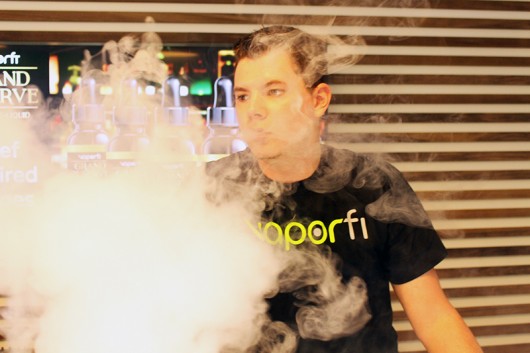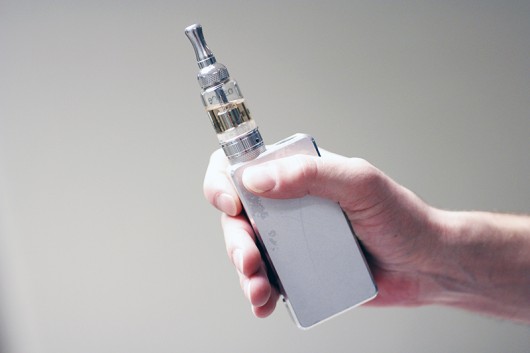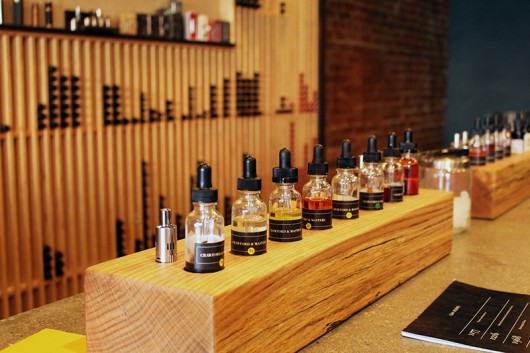
Cody Byrd, a third-year in business and marketing, vapes at Vaporfi, 2471 N. High St, his place of employment. Credit: Hannah Herner | Assistant Arts&Life Editor
In 2014, Ohio State initiated its tobacco-free policy on campus. According to a press release, the goal of the policy is “to support individuals to be tobacco free (and) achieve their highest state of health.” The trend of vaping is included in the ban, but some see it as a better alternative.
Vaping involves using a vaporizer, which can take multiple shapes and is sometimes referred to as an e-cigarette. The device converts a liquid containing varying nicotine and flavoring levels into vapor. Students are turning to vaping to curb their cravings for traditional tobacco products, and it can become a hobby or even a lifestyle for some.
Mark Bardford, manager at Crawford & Masters boutique vapors at 1177 N. High St., said that the majority of the customers he sees have the intention of quitting smoking through vaping, a sentiment that was echoed by Amanda Verbsky, district manager for Vaporfi, which has a location at 2471 N. High St.
Verbsky used vaping to help her quit smoking, and about 80 percent of her customers are trying to do the same. She said it started as a casual cigarette here and there and grew into a pack-a-day addiction.
“When I got the job with Vaporfi, I did not think I would quit smoking,” Verbsky said. “Within three weeks of me working here, I had completely quit smoking.”
Steven Workman, a third-year in strategic communication, said that vaping helped him quit using smokeless tobacco.
“It was pretty much just to help me to quit using smokeless tobacco, and it’s done that. I pretty much just vape now,” he said.
Bardford had quit smoking 20 years prior, and he now vapes with no nicotine just so he can try the flavors. He added that he believes vaping is less harmful than cigarettes in cutting out some of the harmful tars and ingredients, but it can be counter-intuitive if the user smokes with the vaporizer more often than he or she would a traditional cigarette.
“A lot of people will get on these and they’ll start hitting these even more than they did a cigarette because you have the flavor aspect, too,” Bardford said.

A vape pen also known as an E-cigarette. Credit: Samantha Hollingshead | Photo Editor
Bardford emphasized that while vaping can help make the quitting process easier, the user still needs willpower to be successful.
“These aren’t a total cure to it; they take away the need for nicotine and allow you to come down slowly off of it, but you have to want to quit,” he said.
Furthermore, Bardford said he would not recommend vaping to people who have never smoked.
“We get a lot of young people in that want to get into it and they’ve never smoked or anything. I tell them right up front, ‘Hey if you haven’t been smoking, don’t start.’ They don’t understand how addictive nicotine can be, so we try to discourage them,” he said.
In reality, not all vaporizer users have the goal of quitting smoking.
“I even have customers that just use it for anxiety. The deep breathing just helps them calm down,” Verbsky said.
In building vaping devices and experimenting with liquids, it can also be considered a hobby, or even more than that.
“Is it a lifestyle? Is OSU football a lifestyle? Same thing. It’s become a hobby with a lot of people,” Bardford said.
Verbsky said there is a community that has formed around vaping, and people enjoy experimenting with the mechanical aspects of the vaporizers, changing up the coils that heat up the liquid, turning it to vapor.
“You’ll see whole friendships formed on people building coils and trying out different wires and that. It’s really taken on this whole new subculture,” she said.

A display of vaping liquids at Crawford & Masters, 1177 N. High St. Credit: Hannah Herner | Assistant Arts&Life Editor
But the newly formed community comes with its share of criticism.
Bardford said he believes that stigma lies in the nicotine in the vape because it is a derivative of tobacco.
“People see it, they equate it with a cigarette immediately,” he said.
Verbsky emphasized the importance of asking the owners of an establishment before vaping inside, and Bardford echoed the sentiment.
“Some of the community isn’t too great at relaying their feelings about vaping. They’re blowing clouds in places they shouldn’t, they’re being rude about it,” Bardford said.
That is the reason why Workman said he does not use his vaporizer on campus.
“I try not to blow it in people’s faces, and that’s the reason I don’t do it on campus. It’s kind of a politeness thing, too. I guess I wouldn’t want cigarette smokers to smoke around me, so I just try to respect that,” he said.
But Verbsky insisted that the vapor exhaled does not have an adverse affect on people nearby.
“There is no second-hand absorption of even the nicotine. By the time you exhale the water vapor, it dissipates into the air and it’s gone,” she said.
She added that she believes a lot of the criticism comes from people not being familiar with vaping, and its position as an alternative to smoking is most important.
“A lot of people just don’t know what it is,” Verbsky said. “At the end of the day, I really see it as a better alternative to cigarettes or chewing or any of those other things that people have started on.”


